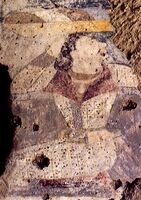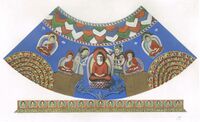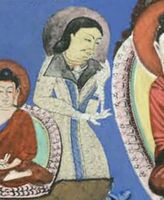يابغو تخارا
يابغو تخارا (625-758 م) | |||||||||||||||
|---|---|---|---|---|---|---|---|---|---|---|---|---|---|---|---|
| العاصمة | قندوز | ||||||||||||||
| الدين | البوذية[4] | ||||||||||||||
| الحكومة | ملكية | ||||||||||||||
• ح. 625 م | Tardush Shad | ||||||||||||||
| الحقبة التاريخية | مطلع العصور الوسطى | ||||||||||||||
| |||||||||||||||
| Today part of | أفغانستان, پاكستان، أوزبكستان و طاجيكستان | ||||||||||||||
يابغو تخارا أو يابغو تخارستان (الصينية: 吐火羅葉護; پنين: Tǔhuǒluó Yèhù)، كانت أسرة حاكمة من الملوك الثانويين الترك الغربيين-الهياطل، بلقب "يابغو"، الذين حكموا من 625 م في منطقة تخارستان شمال وجنوب نهر جيحون، مع بعض البقايا الأصغر استمرت في منطقة بدخشان حتى 758 م. وقد امتدت ذكراهم إلى الجنوب الشرقي حتى القرن التاسع الميلادي، مع ترك شاهي و أسرة زنبيل.
التوسع الإقليمي
The Turks initially occupied the area of north of the Oxus (بلاد ما وراء النهر، بلاد الصغد) following their destruction of the Hephthalites in 557–565 CE through an alliance with the الامبراطورية الساسانية. The Sasanians, on the other hand, took control of the area south of the Oxus, with Chaganiyan, السند, Bust, Rukhkhaj, Zabulistan, تخارستان, Turistan and Balistan being transformed into vassal kingdoms and principalities.[5] After this time, a tense Turco-Persian border existed along the Oxus, which lasted several decades. The area south of the Oxus contained numerous Hephthalites principalities, remnants of the great Hephthalite Empire destroyed by the alliance of the Turks and the Sasanians.[6]
أول هجوم على طخارستان (569-570 م)
In 569-570, the Turks launched an offensive against the Sasanian Empire, and conquered the Hephthalite principalities south of the Oxus belonging to the Sasanian Empire. At that time the Sasanian Empire was embroiled in a war in the west, with the Byzantine Empire. It seems the Turks reached the Kabul–Gandhara area in 570.[6] The principalities of the Hephthalites, formerly vassals of the Sasanian Empire, accepted Turk supremacy and became vassals of the Western Turk qaghan, and the Alchon Huns continued to rule in Kabul and Gandhara, but the Turks apparently did not permanently occupy the territory south of the Oxus.[6] The Hephthalites aspired to independence from the Turks, and in 581 or 582 CE, they revolted in alliance with the Sasanians against the Turk Kaghan Tardu.[6]
ثاني هجوم على طخارستان (588-589 م)
In 588-589, the Turks under Bagha Qaghan entered into a direct conflict with the Sasanians, in the First Perso-Turkic War. The Turks invaded the Sasanian territories south of the Oxus, where they attacked and routed the Sasanian soldiers stationed in Balkh, and then proceeded to conquer the city along with Talaqan, Badghis, and Herat.[7] But the Turks were defeated by the Sasanians under Bahram Chobin, who entered the area north of the Oxus and killed the Turkish Khagan.[8]
الحرب على الإمبراطورية الساسانية (616–617 م)
A war war broke out between the Sasanians and the Hephthalites in 606-607 or 616–617 CE, the Second Perso-Turkic War. At that time, the Türk kaghan sent an army to help the Hephthalites, and was able to bring a great defeat upon the Sasanians, advancing his troops as far as Ray and Isfahan, but Sheguy Kaghan recalled his armies without pressing his advantage.[9]
احتلال طخارستان تحت تونگ يابغو قاغان (625 م)
The Turks definitely intended to take control of the territories south of the Oxus, but were only ready sometime later, and took the opportunity when the Sasanian Empire again entered into conflict with the Byzantine Empire.[15]
In 625, Tong Yabgu invaded Tokharistan and forced the Hephtalite principalities to submit.[16][17] He went as far as the Indus river and took control of all the intervening principalities, replacing Hepthalite rulers by Turk ones.[15] The Turks were victorious, partly because the Sasanian Empire was into a difficult war with the Byzantine Empire, the Byzantine–Sasanian War of 602–628.[15]
According to Cefu Yuangui, these principalities were Zabulistan, Kapisa-Gandhara, Khuttal, Chaghaniyan, Shignan, Shuman, Badhgis, Wakhan, Guzgan, Bamiyan, Kobadiyan and Badakhshan.[15][18] The areas of Khuttal and Kapisa-Gandhara had remained independent kingdoms under the easternmost "Hephthalites" (actually Alchon Hun) under kings such as Narendra, before being taken over as vassals by the Western Turks.[15] The appearance of the "crown with a bull's head" on the coin portraits of the last rulers of Kapisa-Gandhara Narendra II, can be considered as a sign of recognition of Turk sovereignty, since the title buqa (bull) had been in use from 599, when Khagan Tardu united the Turk Empire.[15]
Tong Yabghu Qaghan then installed his son Tardush Shad (الصينية: 達頭设; پنين: Dátóu Shè), as the first yabgu (sub-king) of Tokharistan, controlling all the new Turk realm south of the Oxus, from his capital at Kunduz.[15]
عهد تاردوش شاد (625-630)
Tardush Shad (الصينية: 達頭设; پنين: Dátóu Shè) was installed in Tokharistan, and ruled in Kunduz with title of Tokharistan Yabgu (الصينية: 吐火羅葉護; پنين: Tǔhuǒluó Yèhù). He was married two times - both a daughter of Qu Boya (麴伯雅) - ruler of Qocho. When Xuanzang visited Kunduz, he also brought a letter from his brother-in-law and ruler of Qocho Qu Wentai (麴文泰) to Tardu. Yabgu received him despite being in ill condition. It was Tardu to advise him to make a trip westward to Balkh (modern Afghanistan), to see the Buddhist sites and relics. Xuanzang also witnessed a palace scandal when Tardu's firstborn son Ishbara Tegin fallen in love with his new step-mother (also aunt) and poisoned Tardu in 630.[19]
عهد إشبارا يابغو (630-650)
Ishbara Yabgu (الصينية: 阿史那沙钵罗; پنين: Ashina Shaboluo) was the son of Tardu Shad, and took over as Tokharistan Yabgu.[15] He was the first Tokharistan Yabghu to mint coins.[15] In these coins, in Sasanian style, he effigy represents him bearing a crown decorated with the bull's head and two wings. In one of the issues, the legend is: šb’lk’ yyp MLK’ (Išbara Jeb ˇ [= yabghu] šah, on the obverse) and pnˇcdh. h. wsp’ ("[minted in his] 15th [regnal year at] Khusp", on the reverse). This would date the coin to 645 CE, with a location for the mint at Khusp, Kuhistan.[20] Other known mints are Herat and Shuburgan.[20]
After 650 however, the power of the Yabghus of Tokharistan fragmented, as they came, as least partially, under Tang suzerainty.[20] A Türk yabghu of Tokharistan recorded under the name of "Wu-shih-po of the A-shih-na dynasty" was the first yabghu to be confirmed by the Chinese Emperor.[21]
In 652–653 CE, the Arabs under Abdallah ibn Amir conquered the whole of Tokharistan and captured the city of Balkh, as part of the Muslim conquests of Afghanistan.[20]
The Western Turkic Khaganate itself was destroyed by the Tang Dynasty in 657 CE, and most of his territories became protectorates of the Tang Empire, and organized into regional commanderies.[20] Kunduz became the site of the Yuezhi Commandery (月氏都督府, Yuèzhī Dūdùfû) under administration of the Anxi Protectorate.[22]
During the rule of the Umayyad caliph Ali (656–661), the Arabs were expulsed from eastern Iran, as far as Nishapur and the Sasanian Peroz III was able to establish some level of control with the help of the yabghu of Tokharistan in Seistan.[15]
عهد پانتو نيلي (ح.705 م)
In 705, P’an-tu-ni-li, the yabghu of Tokharistan, is recorded as having sent a mission to the Chinese court.[23] He ruled from Badakshan, as the area of Balkh and the central areas of his territory were occupied by the Arabs, including Shuburgan, Khusp and Herat.[23]
السيادة على الأقاليم شمال وجنوب الهندوكوش

According to the chronicles of the Chinese Cefu Yuangui, a young brother of Pantu Nili named Puluo (僕羅 púluó in Chinese sources) again visited the Tang court in 718 and gave an account of the military forces in the Tokharistan region.[24] Puluo described the power of "the Kings of Tokharistan", explaining that "Two hundred and twelve kingdoms, governors and prefects" recognize the authority of the Yabghus, and that it has been so since the time of his grand-father, that is, probably since the time of the establishment of the Yabghus of Tokharistan.[25] The territory of Guzgan was also mentioned among the territories controlled by the Yabghus.[25] Puluo finally reaffirmed the loyalty of Yabghu Pantu Nili towards the Tang Dynasty.[25]
Part of the Chinese entry for this account by Puluo is:
六年十一月丁未阿史特勒僕羅上書訴曰:僕羅克吐火羅葉護部下管諸國王都督刺史總二百一十二人謝芄王統領兵馬二十萬眾潯齬王統領兵馬二十萬眾骨吐國王石汗那國王解蘇國王石匿國王悒達國王護密國王護時健國王範延國王久越德建國王勃特山王各領五萬眾。僕羅祖父已來並是上件諸國之王蕃望尊重。
On the Dingwei day of the eleventh month in the sixth year [of the Kaiyuan era (713–741 CE)], Ashi Tegin Puluo writes to the emperor: the Kings of States, Commander-in-chiefs (都督 Dudu) and Regional Inspectors (刺史 Cishi) under the Yabghu of Tokharistan,[أ] the elder brother of Puluo, number two hundred and twelve, in all. The king of Zabul[ب] is in charge of infantry and cavalry numbering two hundred thousand, and the king of Kabul[ت] is also in charge of two hundred thousand infantry and cavalry. The Kings of the States of Khuttal,[ث] Chaghanian,[ج] Jiesu,[ح] Shughnan,[خ] Yeda,[د] Humi,[ذ] Guzganan,[ر] Bamiyan,[ز] Quwādhiyān,[س] and Badakhshan[ش] each lead fifty thousand troops. Since the grandfather of Puluo, the Yehu Tuhuolo [Yabghu of Tokharistan] has become king of the above-mentioned states: he is greatly respected."
This account also shows that the Yabghu of Tokharistan ruled a vast area circa 718 CE, formed of the territories north and south of the Hindu Kush, including the areas of Kabul and Zabul.[1]
الاتصالات مع الإمبراطورية البيزنطية
The East Roman Emperor Leo III the Isaurian who had defeated their common enemy the Arabs in 717 CE, sent an embassy to China through Central Asia in 719 CE which probably met with the Tokhara Yabghus and the Turk Shahis, who in honour of the Byzantine Emperor even named one of their own rulers "Caesar of Rome" (which they rendered phonetically as King "Fromo Kesaro").[32][ص] The Chinese annals record that "In the first month of the seventh year of the period Kaiyuan [719 CE] their Lord [拂菻王, "the King of Fulin"] sent the Ta-shou-ling [an officer of high rank] of T'u-huo-lo [吐火羅, Tokhara] (...) to offer lions and ling-yang [antelopes], two of each. A few months after, he further sent Ta-te-seng ["priests of great virtue"] to our court with tribute."[33]
المصادر الصينية
Turk ("T’u-chüeh") kingdoms were in the territories of Gandhara, Kapisa and Zabulistan around 723-729 CE, according to the testimony the Korean pilgrim Hui Chao.[15] Huei-chao also mentioned that in 726 CE, the Arabs occupied Balkh, and the Turks were forced to flee to Badakshan:
I arrived in Tokharistan (吐火羅國 Tuhuoluo-guo). The home city of the king is called Balkh (縛底那). At this time the troops of the Arabs (大寔國)[ض] are there and they occupy it. Its King, Wives and Court was forced to flee one month's journey to the east and lives in Badakhshan. Now Balkh belongs to the Arabs' domain. (...) The King, the nobles and the people revere the Three Jewels (Buddhism). There are many monasteries and monks; they practice the Hinayana teachings.
Chinese sources mention a few years later yabghus who sent missions to the Tang court: Ku-tu-lu Tun Ta-tu (Qutluγ Ton Tardu) asked for help against the Arabs in 729 CE, Shih-li-mang-kia-lo (Sri Mangala) asked for help against the Tibetans in 749 CE, and received this help from the Chinese, and in 758 CE Wu-na-to (Udita?) visited in person the Chinese court and participated in the fight against the rebel An Lu-shan.[23]
کاپیسا-گندهارا
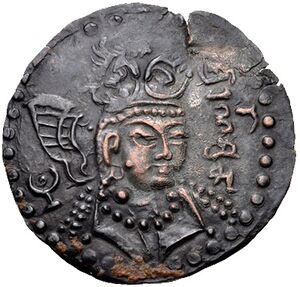
In the area of کاپیسا-گندهارا, the Turk Shahi (665–850 CE), a probable political extension and vassals of the neighbouring Yabghus of Tokharistan, remained an obstacle to the eastward expansion of the Abbasid Caliphate.[32][1]
Circa 650 CE, the Arabs attacked Shahi territory from the west, and captured Kabul.[32] But the Turk Shahi were able to mount a counter-offensive and repulsed the Arabs, taking back the areas of Kabul and Zabulistan (around Ghazni), as well as the region of Arachosia as far as Kandahar.[32] The Arabs again failed to capture Kabul and Zabulistan in 697-698 CE, and their general Yazid ibn Ziyad was killed in the action.[32]
From 719 CE, Tegin Shah was the king of the Turk Shahis. He then abdicated in 739 CE in favour of his son Fromo Kesaro, probable phonetic transcription of "Caesar of Rome" in honor of "Caesar", the title of the then East Roman Emperor Leo III the Isaurian who had defeated their common enemy the Arabs in 717 CE, and sent an embassy through Central Asia in 719 CE.[32][ط] Fromo Kesaro appears to have fought vigorously against the Arabs, and his victories may have forged the Tibetan epic legend of King Phrom Ge-sar.[32]
The Turk Shahis eventually weakened against the Arabs in the late 9th century CE.[32] قندهار وكابول و زابل were lost to the Arabs, while in Gandhara the Hindu Shahi took over. The last Shahi ruler of Kabul, Lagaturman, was deposed by a Brahmin minister, possibly named Vakkadeva,[37][38][39] in c. 850, signaling the end of the Buddhist Turk Shahi dynasty, and the beginning of the Hindu Shahi dynasty of Kabul.[40]
Local art at the time of the Yabghus of Tokharistan (7-8th century CE)
These was a relatively high level of artistic activity in the areas controlled by the Yabghus of Tokharistan during 7-8th centuries CE, either as a result of the Sasanian cultural heritage, or as a result of the continued development of Buddhist art.[41] The works of art of this period in Afghanistan, with a sophistication and cosmopolitanism comparable to other works of art of the Silk Road such as those of Kizil, are attributable to the sponsorship of the Turks.[42]
Shallow bowl, probably from Afghanistan (said to have been discovered in northwestern India), Sasanian period, 5th-7th century CE.[45]
Goddess, possibly Nana, seated on a lion, 5th-6th century, Afghanistan, Hephthalite or Turkic period.[46]
Buddhism
Buddhism in Tokharistan is said to have enjoyed a revival under the Turks. Several monasteries of Tokharistan dated to the 7th-8th centuries display beautiful Buddhist works of art, such as Kalai Kafirnigan, Ajina Tepe, Khisht Tepe or Kafyr Kala, around which Turkic nobility and populations followed Hinayana Buddhism.[47] The Turks were apparently quite tolerant of other religions.[47]
Female devotee in Kalai Kafirnigan. 7th-early 8th century.[47]
Buddhist mural from the monastery at Ajina Tepe. Dushanbe - National Museum of Antiquities.[47]
Bamiyan murals and their devotees
The mural paintings of Bamiyan display male devotees in double-lapel caftans, also attributable to the local sponsorship of the Western Turks.[42]
Devotee in double-lapel caftan, left wall of the niche of the 53 meter Buddha. Bamiyan
References
- ^ أ ب ت "The account herewith quoted as 3.5. shows that this king of Tokhara had political power to control the principalities belonging to the Governors-General to the north and the south of the Hindukush, not to mention the Yuezhi Governor General." in Kuwayama, Shoshin (2005). "Chinese Records on Bamiyan: Translation and Commentary". East and West. 55 (1/4): 153, 3–5. ISSN 0012-8376. JSTOR 29757642.
- ^ Detailed list of vassal cities and regions in ancient Chinese sources: Taishan, Y. U. (2012). 歐亞學刊 新3辑 (Eurasian Studies III): Records Relevant to the Hephthalites in Ancient Chinese Historical Works (in الإنجليزية). 中華書局. p. 250.
- ^ أ ب ت Kuwayama, Shoshin (2005). "Chinese Records on Bamiyan: Translation and Commentary". East and West. 55 (1/4): 143–144. ISSN 0012-8376. JSTOR 29757642.
- ^ أ ب Akasoy, Anna; Burnett, Charles; Yoeli-Tlalim, Ronit (14 December 2016). Islam and Tibet – Interactions along the Musk Routes (in الإنجليزية). Routledge. p. 55. ISBN 978-1-351-92605-8.
- ^ Dani, Ahmad Hasan; Litvinsky, B. A. (January 1996). History of Civilizations of Central Asia: The crossroads of civilizations, A.D. 250 to 750 (in الإنجليزية). UNESCO. p. 367. ISBN 978-92-3-103211-0.
- ^ أ ب ت ث Dani, Ahmad Hasan; Litvinsky, B. A. (January 1996). History of Civilizations of Central Asia: The crossroads of civilizations, A.D. 250 to 750 (in الإنجليزية). UNESCO. p. 368. ISBN 978-92-3-103211-0.
- ^ Rezakhani 2017, p. 177.
- ^ Rezakhani 2017, p. 178.
- ^ Dani, Ahmad Hasan (1999). History of Civilizations of Central Asia: The crossroads of civilizations: A.D. 250 to 750 (in الإنجليزية). Motilal Banarsidass Publ. p. 369. ISBN 978-81-208-1540-7.
- ^ Baumer, Christoph (18 April 2018). History of Central Asia, The: 4-volume set (in الإنجليزية). Bloomsbury Publishing. p. 243. ISBN 978-1-83860-868-2.
- ^ Grenet, Frantz (2004). "Maracanda/Samarkand, une métropole pré-mongole". Annales. Histoire, Sciences Sociales. 5/6: Fig. B.
- ^ Whitfield, Susan (2004). The Silk Road: Trade, Travel, War and Faith (in الإنجليزية). British Library. Serindia Publications, Inc. p. 110. ISBN 978-1-932476-13-2.
- ^ Yatsenko, Sergey A. (2009). "Early Turks: Male Costume in the Chinese Art Second half of the 6th – first half of the 8th cc. (Images of 'Others')". Transoxiana. 14: Fig.25.
- ^ Millward, James A. (2007). Eurasian Crossroads: A History of Xinjiang (in الإنجليزية). Columbia University Press. p. 31. ISBN 978-0-231-13924-3.
- ^ أ ب ت ث ج ح خ د ذ ر ز "The definitive annexation of Tokharistan and Gandhara to the Western Türk Empire was to take place some years later, in c. 625, when Sasanian Iran became involved in the war against Byzantium that ultimately led to its eclipse." in Dani, Ahmad Hasan; Litvinsky, B. A. (January 1996). History of Civilizations of Central Asia: The crossroads of civilizations, A.D. 250 to 750 (in الإنجليزية). UNESCO. pp. 370–375. ISBN 978-92-3-103211-0.
- ^ History of civilizations of Central Asia. Dani, Ahmad Hasan., Masson, V. M. (Vadim Mikhaĭlovich), 1929-, Harmatta, J. (János), 1917-2004., Puri, Baij Nath., Etemadi, G. F., Litvinskiĭ, B. A. (Boris Anatolʹevich). Paris: Unesco. 1992–2005. pp. 370. ISBN 978-9231027192. OCLC 28186754.
{{cite book}}: CS1 maint: others (link) - ^ Chavannes, Edouard; . (2006). Documents sur les Tou-Kiue (turcs) occidentaux. Classiques des sciences sociales. Chicoutimi: J.-M. Tremblay. p. 196. doi:10.1522/24885129. ISBN 978-9781412356.
{{cite book}}:|last2=has numeric name (help) - ^ "Cefu Yuangui, vol 999 | 冊府元龜/卷0999 - 维基文库,自由的图书馆". zh.wikisource.org (in الصينية). Retrieved 2018-08-21.
- ^ 1840-1901., Watters, Thomas (1975). On Yuan Chwang's travels in India, 629-645 A.D. Chinese Materials Center. p. 107. ISBN 978-1406713879. OCLC 2959831.
{{cite book}}:|last=has numeric name (help)CS1 maint: multiple names: authors list (link) - ^ أ ب ت ث ج Dani, Ahmad Hasan; Litvinsky, B. A. (January 1996). History of Civilizations of Central Asia: The crossroads of civilizations, A.D. 250 to 750 (in الإنجليزية). UNESCO. pp. 371–375. ISBN 978-92-3-103211-0.
- ^ "The first Türk yabghu (king) of Tokharistan, confirmed by the Chinese emperor, was Wu-shih-po of the A-shih-na dynasty." in Dani, Ahmad Hasan; Litvinsky, B. A. (January 1996). History of Civilizations of Central Asia: The crossroads of civilizations, A.D. 250 to 750 (in الإنجليزية). UNESCO. p. 372. ISBN 978-92-3-103211-0.
- ^ Theobald, Ulrich. "The Western Territories 西域 (www.chinaknowledge.de)". www.chinaknowledge.de (in الإنجليزية).
- ^ أ ب ت Dani, Ahmad Hasan; Litvinsky, B. A. (January 1996). History of Civilizations of Central Asia: The crossroads of civilizations, A.D. 250 to 750 (in الإنجليزية). UNESCO. p. 372. ISBN 978-92-3-103211-0.
- ^ Kuwayama, S. (2002). Across the Hindukush of the First Millennium: a collection of the papers (PDF). Kyoto University. p. 139.
- ^ أ ب ت Sims-Williams, Nicholas (2002). "Nouveaux document bactriens du Guzgan (note d'information)". Comptes rendus des séances de l'Académie des Inscriptions et Belles-Lettres. 146 (3): 1057. doi:10.3406/crai.2002.22500.
- ^ أ ب ت ث ج ح خ د ذ ر Taishan, Y. U. (2012). 歐亞學刊 新3辑 (Eurasian Studies III): Records Relevant to the Hephthalites in Ancient Chinese Historical Works (in الإنجليزية). 中華書局. p. 250.
- ^ Theobald, Ulrich. "The Western Territories 西域". www.chinaknowledge.de (in الإنجليزية).
- ^ Paragraph 69 in: "冊府元龜 : 卷九百九十九 - Chinese Text Project". ctext.org (in الإنجليزية).
- ^ Morgan, Llewelyn (18 June 2012). The Buddhas of Bamiyan (in الإنجليزية). Harvard University Press. pp. 46–47. ISBN 978-0-674-06538-3.
- ^ أ ب Jan, Yun-Hua; Iida, Shotaro; Yang, Han-Sung (1984). The Hye Ch'O Diary: Memoir of the Pilgrimage to the Five Regions of India (Religions of Asia Series) (English and Korean ed.). Asian Humanities Pr. p. 52. ISBN 978-0895810243.
- ^ Original text:
又從此犯引國。北行二十日。至吐火羅國。王住城名為縛底那。見今大寔兵馬。在彼鎮押。其王被其王被逼。走向東一月程。在蒲持山。住見屬大寔所管。言音與諸國別。共罽賓國少有相似。多分不同。衣著皮毬㲲布等。上至國王。下及黎庶。皆以皮毬。為上服。土地足駝騾羊馬㲲布蒲桃。食唯愛餅。土地寒冷。冬天霜雪也。國王首領及百姓等。甚敬三寶。足寺足僧。行小乘法。食內及葱蕜等。不事外道。男人並剪鬚髮。女人在髮土地足山
in "徃五天竺國傳 CBETA 漢文大藏經". tripitaka.cbeta.org..
Translation from the original:
"From Bamiyan (犯引國) I travelled further north and after twenty days arrived at the country of Tokharistan (吐火羅國 Tuhuoluo-guo). The capital city is called Pactra (Balkh 縛底那). At present, the place is guarded and oppressed by Arab forces (大寔兵馬). The original king was compelled to leave the capital, and he resided at Badakshan (蒲持山), which is one month's journey from the capital towards the east. It is also under the authority of the Arabs. The language [of this country] is different from that of other countries. Though it is similar to the language of Kapisa (Jibin, 罽賓國), for the most part it is different. The dress is mostly made of fur, cotton, and similar things. From the king and chiefs down to the common people, all use fur as the outer garment. The land has many camels, mules, sheep and grapes. As far as food is concerned, the people are only fond of pastry. The land is cold. There is fog and snow during the winter. The king, the chiefs, and the common people respect the Three Jewels (Triratna 三寶). There are many monasteries and monks. Hinayana Buddhism (小乘法) is practised. They eat meat, onions, and leeks. They do not profess any other religions. All men cut their beards and hair, but women keep their hair. The land is mountainous"
Adapted from Jan, Yun-Hua; Iida, Shotaro; Yang, Han-Sung (1984). The Hye Ch'O Diary: Memoir of the Pilgrimage to the Five Regions of India (Religions of Asia Series) (English and Korean ed.). Asian Humanities Pr. p. 52. ISBN 978-0895810243. - ^ أ ب ت ث ج ح خ د Kim, Hyun Jin (19 November 2015). The Huns (in الإنجليزية). Routledge. pp. 58–59. ISBN 978-1-317-34090-4.
- ^ Old Book of Tang (舊唐書 Jiu Tangshu), ch. 198 (written mid-10th Century C.E.), for 618-906 C.E: "開元七年正月,其主遣吐火羅大首領獻獅子、羚羊各二。不數月,又遣大德僧來朝貢" quoted in English translation in Hirth, F. (1885). China and the Roman Orient: Researches into their Ancient and Mediaeval Relations as Represented in Old Chinese Records. Shanghai & Hong Kong.
{{cite book}}: CS1 maint: location missing publisher (link) - ^ Göbl 1967, 254 ; Vondrovec tyre 254
- ^ "The Countenance of the other (The Coins of the Huns and Western Turks in Central Asia and India) 2012-2013 exhibit". Pro.geo.univie.ac.at. Kunsthistorisches Museum Vienna. Retrieved July 16, 2017.
- ^ Alram, Michael; Filigenzi, Anna; Kinberger, Michaela; Nell, Daniel; Pfisterer, Matthias; Vondrovec, Klaus. "The Countenance of the other (The Coins of the Huns and Western Turks in Central Asia and India) 2012-2013 exhibit: 13. THE TURK SHAHIS IN KABULISTAN". Pro.geo.univie.ac.at. Kunsthistorisches Museum Vienna. Retrieved July 16, 2017.
- ^ D. W. Macdowall, "The Shahis of Kabul and Gandhara" Numismatic Chronicle, Seventh Series, Vol. III, 1968, pp. 189-224, see extracts in R. T. Mohan, AFGHANISTAN REVISITED … Appendix –B, pp. 164-68
- ^ Raizada Harichand Vaid, Gulshane Mohyali, II, pp. 83 and 183-84.
- ^ H. G. Raverty, Tr. Tabaqat-i-Nasiri of Maulana Minhaj-ud-din, Vol. I, p. 82
- ^ "The Countenance of the other (The Coins of the Huns and Western Turks in Central Asia and India) 2012-2013 exhibit: 16. The Hindu Shahis in Kabulistan and Gandhara and the Arab conquest". Pro.geo.univie.ac.at. Retrieved July 22, 2017.
- ^ Compareti, Matteo (2008). "The Painting of the "Hunter-King" at Kakrak: Royal Figure or Divine Being?". Studio Editoriale Gordini: 133.
- ^ أ ب Bosworth also says that the "Ephthalites were incapable of such work" (he conflates the in Hephthalites and the Alchon Huns), in Bosworth, C. Edmund (15 May 2017). The Turks in the Early Islamic World (in الإنجليزية). Routledge. p. 145. ISBN 978-1-351-88087-9.
- ^ Huntington, John C. "Images of the Crowned Buddha along the Silk Road: Iconography and Ideology".
- ^ Wong, Dorothy C. (28 April 2018). Buddhist Pilgrim-Monks as Agents of Cultural and Artistic Transmission: The International Buddhist Art Style in East Asia, ca. 645-770 (in الإنجليزية). NUS Press. p. 78. ISBN 978-981-4722-59-9.
- ^ Gunter, Ann C.; Jett, Paul (1992). ANCIENT IRANIAN METALWORK IN THE ARTHUR M. SACKLER GALLERY AND THE FREER GALLERY OF ART (PDF). Smithsonian Institution, Washin2;ton, D.C. pp. 148–152.
- ^ "Metropolitan Museum of Art". www.metmuseum.org.
- ^ أ ب ت ث ج Baumer, Christoph. History of Central Asia, The: 4-volume set (in الإنجليزية). Bloomsbury Publishing. pp. 203–204. ISBN 978-1-83860-868-2.
- ^ Litvinskij, B. A. (1981). "Kalai-Kafirnigan Problems in the Religion and Art of Early Mediaeval Tokharistan" (PDF). East and West. 31 (1/4): 35–66. ISSN 0012-8376.
Notes
- ^ 葉護吐火羅 Yehu of Tuhuoluo[26]
- ^ 謝芄 Xieyang. "The state of Xieyang (Zābulistān) was located between Kabuland and Kandahar."[26]
- ^ 潯齬, Kabul or Jibin depending on the source.[26][3]
- ^ 骨吐國 Gutuo-guo
- ^ 石汗那國 Shihanna-guo "The state of Shihanna (Čaghaniyān) was located in Denau on the upper stream of the Surkhan River"[26]
- ^ 解蘇國 Jiesu-guo "The state of Jiesu was simply the state of Yuman (Shūmān) near presentday Dushanbe"[26]
- ^ 石匿國 Shini
- ^ 悒達國 Yida "Yida is simply Yeda"[26] "Taihan 太汗都督府 or Dahan 大汗" was the "former territory of the Hephthalites (Yeda 嚈噠), the city of Huolu 活路 (modern Mazār-e Sherif, Afghanistan)"[27]
- ^ 護密國 Humi-guo "The state of Humi (Komedae) was located in present-day Sarik-Čaupan and the surrounding area in the Wakhan valley."[26]
- ^ 護時健國 Hushijian-guo "The state of Hushijian (Gūzgānān) was located between Merv and Balkh"[26]
- ^ 範延國 Fanyan-guo
- ^ 久越德建國 Jiuyuedejian-guo "The state of Jiuyuedejian (Quwādhiyān) was on the lower stream of the Kafirnihan River, near present-day Qobadian"[26]
- ^ 勃特山 Boteshan
- ^ Martin 2011, p. 127:"He received this laudatory epithet because he, like the Byzantines, was successful at holding back the Muslim conquerors."
- ^ This is the first mention of the Arab as "Dashi" (大寔 or 大食) in a Chinese text. See The Silk Road Encyclopedia (in الإنجليزية). Seoul Selection. 18 July 2016. p. 782. ISBN 978-1-62412-076-3.
- ^ Martin 2011, p. 127:"He received this laudatory epithet because he, like the Byzantines, was successful at holding back the Muslim conquerors."
Sources
- Alram, Michael; Filigenzi, Anna; Kinberger, Michaela; Nell, Daniel; Pfisterer, Matthias; Vondrovec, Klaus (2012–2013). "The Countenance of the other (The Coins of the Huns and Western Turks in Central Asia and India) 2012-2013 exhibit". Vienna, Austria: Kunsthistorisches Museum, Coin Cabinet. Retrieved 1 November 2020.
{{cite web}}: External link in|ref= - Rezakhani, Khodadad (2017). ReOrienting the Sasanians: East Iran in Late Antiquity. Edinburgh University Press. pp. 1–256. ISBN 9781474400305.
- Martin, Dan (2011). "Greek and Islamic Medicines' Historical Contact with Tibet". In Akasoy, Anna; Burnett, Charles; Yoeli-Tlalim, Ronit (eds.). Islam and Tibet: Interactions Along the Musk Routes. Farnham, Surrey: Ashgate Publishing. pp. 117–144. ISBN 978-0-7546-6956-2.
- CS1 maint: others
- CS1 errors: numeric name
- CS1 الصينية-language sources (zh)
- CS1 maint: location missing publisher
- Short description is different from Wikidata
- Articles containing Chinese-language text
- Pages using multiple image with auto scaled images
- 7th-century Turkic people
- Turkic Buddhists
- 630 deaths
- Ashina house of the Turkic Empire
- History of Kunduz Province

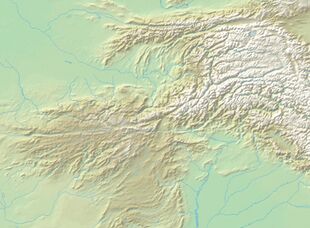

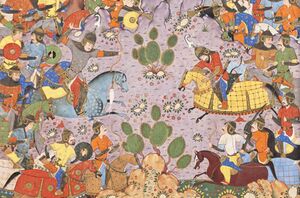

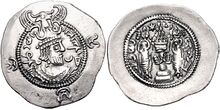
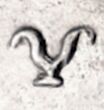
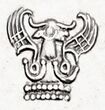
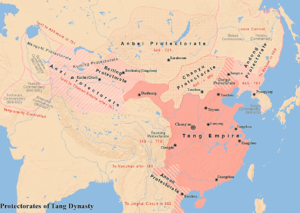

![Buddha wearing a crown and cape. Painting in niche "I" at Bamiyan, 7th century CE.[43][44]](/w/images/thumb/b/ba/Buddha_wearing_a_crown_and_cape._Painting_in_niche_I_at_Bamiyan%2C_7th_century_CE.jpg/175px-Buddha_wearing_a_crown_and_cape._Painting_in_niche_I_at_Bamiyan%2C_7th_century_CE.jpg)
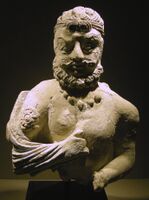
![Shallow bowl, probably from Afghanistan (said to have been discovered in northwestern India), Sasanian period, 5th-7th century CE.[45]](/w/images/thumb/2/2f/Shallow_bowl%2C_probably_Afghanistan%2C_Sasanian_period%2C_5th-7th_century_AD%2C_silver%2C_gilt_-_Arthur_M._Sackler_Gallery_-_DSC05096.jpg/200px-Shallow_bowl%2C_probably_Afghanistan%2C_Sasanian_period%2C_5th-7th_century_AD%2C_silver%2C_gilt_-_Arthur_M._Sackler_Gallery_-_DSC05096.jpg)
![Goddess, possibly Nana, seated on a lion, 5th-6th century, Afghanistan, Hephthalite or Turkic period.[46]](/w/images/thumb/d/d9/Goddess%2C_possibly_Nana%2C_seated_on_a_lion%2C_5th-6th_century%2C_Afghanistan%2C_Hephthalite_or_Turkic_period.jpg/160px-Goddess%2C_possibly_Nana%2C_seated_on_a_lion%2C_5th-6th_century%2C_Afghanistan%2C_Hephthalite_or_Turkic_period.jpg)
![Buddhist mural from Kalai Kafirnigan, Museum of National Antiquities, Dushanbe, Tajikistan. 7th-early 8th century.[47][48]](/w/images/thumb/b/b9/Mural_from_Kalai_Kafirnigan%2C_Museum_of_National_Antiquities%2C_Dushanbe%2C_Tajikistan.jpg/200px-Mural_from_Kalai_Kafirnigan%2C_Museum_of_National_Antiquities%2C_Dushanbe%2C_Tajikistan.jpg)
![Female devotee in Kalai Kafirnigan. 7th-early 8th century.[47]](/w/images/thumb/7/70/Kalai_Kafirnigan_woman.jpg/200px-Kalai_Kafirnigan_woman.jpg)
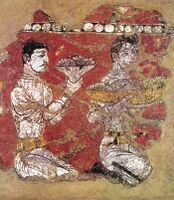
![Buddhist mural from the monastery at Ajina Tepe. Dushanbe - National Museum of Antiquities.[47]](/w/images/thumb/7/73/Dushanbe_-_National_Museum_of_Antiquities_-_Buddhist_Monastery_at_Ajinateppe.jpg/156px-Dushanbe_-_National_Museum_of_Antiquities_-_Buddhist_Monastery_at_Ajinateppe.jpg)
